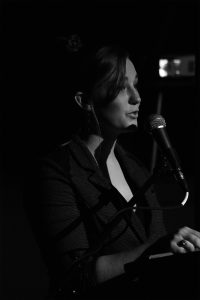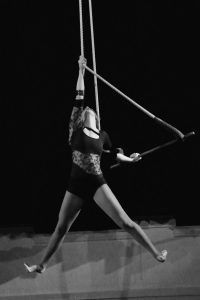Interview with Christiana Lauren Rose

Christiana Rose is a practicer of circus artistry, music and computer technology which is a pretty unique combination. Last month she travelled from Colorado and Oberlin Conservatory to Notam, where she met up with Henrik Sundt, spending a week further developing her project, SALTO, which is an instrument for control of sound with body movements. We wanted to ask her some questions about that.
Could you explain your project?
I am developing a musical interface for trapeze artists, which essentially makes the choreographer become the musician too. It puts them in control of the sound via movement creating an interactive performance with aerial dance and sound. What we are working on now is the Max patch. My first version was limited and not very flexible. We pulled it back apart to all the different layers that are needed within the interface and the system, then opened it back up to make it flexible through machine learning and logics.
Henrik: Mostly we do this in Max, but there are alternatives like Integra – which is a framework for making electronic music tools available to a broader audience. It is more simple to set up these patches, a little like Max, but you don’t have to know all the nerdy details to get things up and running which can be very relevant for working efficiently with an idea.
How, or maybe why, did you come up with this idea, and how can it be implemented?
Mostly it comes from me wanting to combine all of my interests. There is a history of similar projects with modern dance, and so I thought, why not circus? Contemporary circus recently has produced multimedia works, like Cirkus Cirkör’s Limits and has the possibility of reaching a broader audience. With circus there is a big potential because the movements, think of flipping, the vertical height, the distance traveled and gravity, are well suited for sensors to record. One idea could be training the audience to recognize difficult moves through the sonification of pressure. If you are wrapped in ropes of the trapeze there is a lot of pressure on your arms and legs. The muscle sensors can read the activity and the data can be translated into sound, e.g. creating percussive sounds every time the sensors are activated. The sound comes from the body, the physicality being represented. This integrates the artistic and conceptual with the technical and physical means, creating a unique platform for expression.
What are the parameters of the armband?
It uses 8 EMG myoelectric sensors, which are electromagnetic sensors for muscle activity. For instance when you grab something, your neurons start firing and send messages telling your muscles to contract, those messages are little electrical impulses that sensors can pick up. Also, there are two other sensors, an accelerometer and a gyroscope, which give you different information about position, velocity and rotation.
Why Notam?
My professor, Peter Swendsen, helped set up this residency for me. As a recent graduate of Oberlin Conservatory in Ohio, I was looking for professional settings to continue my work. I was going to be in Norway assisting him with the premiere of his work, What Noises Remain? so Notam seemed like the perfect fit to see what’s out there. To take SALTO to the next step I was in need of help with some of the computer programming. Since programming hasn’t been my main focus of study, working with Sundt was a great experience to get the in depth help I needed.
Do you imagine this as a multi speaker setup?
Eventually I think it would be fascinating to spatialize this performance. Even with stereo speakers you, the performer, are listening to this either upside down, or spinning quickly. During the performer’s listening experience filtering occurs, whether that’s from the blood rushing to your head, or because you are spinning, you hear the sound differently. I think it would be very interesting to spatialize the sound in a way which can give the audience a taste of what that feels like to be upside down and spinning around.
How did you get in to the field of technology in music and art?
I started to design instruments after taking courses in computer music, studio recording, and circuitry at Oberlin. Since I was 5 years old, I had been practicing gymnastics competitively and playing classical and jazz piano. I got into music technology in high school when I joined a R & B band and began recording demos. The summer before my senior year I went to Oberlin for summer camp. That was when I first got introduced to electroacoustic music and the Max software. Thinking the camp was going be about keyboards and sampling, and without having heard any electroacoustic music before, when the first concert started, it was all electroacoustic multi-channel works and I thought “I have no idea what this is, but it is awesome!” I fell in love with the music and sonic possibilities then and there. One piece I remember was Moth by Tom Lopez.
Sounds like an interesting place. Does Oberlin differ from other Universities?
Oberlin is certainly a unique place. There are two institutions: the college and the conservatory of music. The Liberal Arts College aims to produce a well-rounded exploration of different disciplines, like arts and technology, and how they connect, while the Conservatory of Music is in traditional western style, with intense performance-based programs, including opera and all the orchestral instruments, a composition and music technology programs. All this is situated in an eclectic place, the middle of the Ohio cornfields where students come to from different backgrounds. It is a small school with no more than 35 students at the biggest lectures. You really get to know your professors, and can develop personal relationships with them. Oberlin takes a critical approach to learning and teaching. It is all undergraduate students, and the professor’s attention is focused on teaching us, not on a graduate or PhD student’s “more important” research.
What is your long time perspective, why do you want this to be available as a tool?
My hope is that other aerialists and choreographers can use this as a tool within their own acts, making the choreographer independent. They can design and choose what they want the sound to be like through some predetermined options. With this, they could continue to use SALTO to create new works and it could become part of their performance practice.
Tell us of your plans for the future!
I will continue to work on these types of instruments for the next five years and hopefully continue this research and development in graduate school. I plan to keep collaborating with aerialists to develop it and see what interest there is – if there is any – to use and work with this kind of technology. Oberlin has been a very safe place, supportive and allowing me to dream big. The other part is: are people actually going to want to perform with this type of technology in circus? or could it be an interesting tool for artists outside of that realm?





Photo and video by Emily Volz. Performer: Katharine Geber